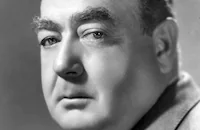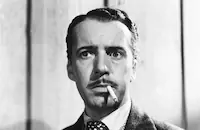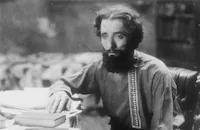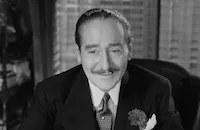The Three Musketeers

Brief Synopsis
Cast & Crew
Fred Niblo
Douglas Fairbanks
Leon Barry
George Siegmann
Eugene Pallette
Boyd Irwin
Film Details
Technical Specs

Synopsis
Cardinal Richelieu, engaged in intrigue at the court of Louis XIII, attempts to rule by threatening the queen, who is secretly in love with the Duke of Buckingham. From Gascony comes D'Artagnan to join the King's Musketeers in his quest for adventure. He wins the right to membership by proving his prowess with the sword and forms an eternal alliance with Athos, Porthos, and Aramis, the Three Musketeers. After many adventures, he embarks on a dangerous mission to England to recover a diamond brooch, a gift of the king, which the queen has given to Buckingham as a token of affection. He recovers it and returns in time to save the queen from the wrath of Louis, defeat the cardinal's intrigue, and win Constance, the queen's seamstress.

Director
Fred Niblo
Cast

Douglas Fairbanks
Leon Barry
George Siegmann

Eugene Pallette

Boyd Irwin
Thomas Holding

Sidney Franklin
Charles Stevens

Nigel De Brulier
Willis Robards
Lon Poff

Mary Maclaren

Marguerite De La Motte

Barbara La Marr
Walt Whitman

Adolphe Menjou
Charles Belcher
Crew
Paul Burns
Doran Cox
Arthur Edeson
Harry Edwards
Frank England
Douglas Fairbanks
Louis F. Gottschalk
Edward Knoblock
Edward M. Langley
Nellie Mason
Albert Wayne
Lotta Woods

Videos
Movie Clip
Hosted Intro
Film Details
Technical Specs

Articles
The Three Musketeers (1921)
Having formed the United Artists distribution company with Pickford, D.W. Griffith, and his best friend, Charlie Chaplin, and producing the film himself for his own Douglas Fairbanks Pictures Corp., the star was free to choose whatever topic suited him, and The Three Musketeers was a perfect fit. Not only was Alexandre Dumas' d'Artagnan Fairbanks' own personal hero, but the novel featured plenty of swordfights and had the potential for the type of graceful stunt work that had thrilled audiences in The Mark of Zorro. Fairbanks and his good friend, the playwright Edward Knoblock, and scenario editor Lotta Woods based the film on Dumas' 1844 novel, but took some significant liberties with the plot in order to focus solely on one episode, namely d'Artagnan's frantic race to recover Queen Anne's (Mary MacLaren) diamond broach from the Duke of Buckingham (Thomas Holding). Other changes are apparent to readers of the novel: to maintain Fairbanks' good-guy image and steer clear of film censors, d'Artagnan's lady-love, Constance Bonacieu (Marguerite De La Motte), was no longer a married woman with whom he has an affair, but single, and the character of her husband was changed to her uncle. Another plot alteration was to remove Constance's poisoning by Milady de Winter (Barbara La Marr), which eliminated Milady's execution at the hands of the Musketeers in a revenge killing, as Dumas wrote. Fairbanks' biggest fans were young boys and it would be unthinkable that a Douglas Fairbanks film could have anything but a happy ending, because that was what they wanted.
Although Fairbanks idolized d'Artagnan from his youth, re-reading the overtly violent and frankly sexual Dumas novel as an adult was a bit of a jolt. He would later remark that it was difficult to make d'Artagnan acceptable for a 1921 audience. "[T]hat fellow was a brute and a bully. He went around picking quarrels with everybody and killing folks who hadn't done anything to get killed for. [...] It sounded all right in the book, but when you showed it in the picture you had to show men being run thru with swords and dying. [...] We steered away from the idea that he was killing people and that the people were dying by always giving his fights a comic finish."
Directed by Fred Niblo, who had just helmed The Mark of Zorro, and filmed by cinematographer Arthur Edeson (who would later shoot Casablanca ,1942) The Three Musketeers co-starred Léon Bary as Athos, George Siegmann as Porthos, and Eugene Pallette as Aramis. Adolphe Menjou played Louis XIII and Nigel De Brulier was Cardinal Richelieu. Shot at both the Douglas Fairbanks Studios for the small sets and the Robert Brunton Studios (later absorbed by Paramount Pictures) for the interiors, the film featured elaborate fight scenes choreographed by fencing expert H.J. Uyttenhove, who spent three months teaching the actors (including Menjou who had no fight scenes but wanted to learn) how to fence. Menjou later remembered that despite careful training by Uyttenhove, once Niblo said action, Fairbanks "went completely unorthodox. He was all over the set, jumping over chairs and on top of tables, lashing away with his rapier as though it were a broadsword. The fencing instructor, who was an expert swordsman, tore his hair." Uyttenhove's protests went unheeded and Fairbanks continued to be Fairbanks. According to Menjou, when The Three Musketeers was released, "fencing experts all over the world groaned at Doug's antics, but there were millions of movie-goers who thought he was the world's greatest swordsman."
The Three Musketeers was a smash hit when it had its world premiere in New York City on August 28, 1921, with Fairbanks, Pickford, Charlie Chaplin, and boxer Jack Dempsey in attendance at the Lyric Theatre on Broadway. Tickets went for the large sum of $2, with scalpers getting as much as $5, to see Fairbanks forced to take bows before and after the film and during intermission. Along with the star, audiences were treated to a full orchestra to play the score and a costumed actor reading a prologue by Knoblock, later used in Fairbanks' sequel The Iron Mask (1929). The New York Herald called the film "[A] kind of combination of Dumas, Douglas, and delirium. One moment it boils with action and the next it snaps and sparkles with humor like d'Artagnan's own rapier." Made for a reported $748,768.76, the film would go on to make over $1.4 million in the United States, and cleaned up overseas, with the exception of France and predominately Francophone countries.
The character of d'Artagnan stuck with Fairbanks; until his sudden death from a heart attack in 1939, he continued to wear d'Artagnan's moustache. Of The Three Musketeers, his son, Douglas Fairbanks, Jr., later mused, "Whether it was d'Artagnan with Douglas Fairbanks or Douglas Fairbanks pretending to be d'Artagnan I don't know. It was an interchangeable identification."
SOURCES:
http://www.afi.com/members/catalog/DetailView.aspx?s=&Movie=12669
Fairbanks, Douglas, and Leigh, Keri Douglas Fairbanks: In His Own Words
Tibbetts, John C. and Welsh, James M. Douglas Fairbanks and the American Century
Vance, Jeffrey, Maietta, Tony and Cushman, Robert Douglas Fairbanks
By Lorraine LoBianco

The Three Musketeers (1921)
Quotes
Trivia
Notes
For information on other films based on the Alexander Dumas novel, please consult the entry for the 1948 M-G-M production of The Three Musketeers, directed by George Sidney and starring Gene Kelly and Lana Turner (see AFI Catalog of Feature Films, 1941-50).

Miscellaneous Notes
Released in United States 1921
Released in United States 1974
Released in United States 1921
Released in United States 1974 (Shown at FILMEX: Los Angeles International Film Exposition (Closing Night) March 28 - April 9, 1974)















